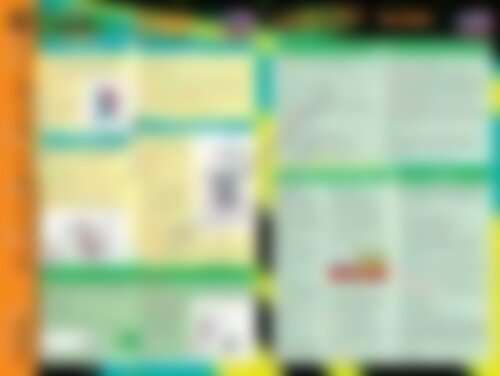RIC-6843 Science Essentials 2 (Ages 11-15)
You also want an ePaper? Increase the reach of your titles
YUMPU automatically turns print PDFs into web optimized ePapers that Google loves.
<strong>Science</strong> Earth science<br />
Forces and energy Chemistry Biology<br />
Biology<br />
THE LUNGS<br />
When we breathe, our lungs take oxygen from<br />
the air and pass it into our bloodstream. The<br />
oxygen is carried to our cells by our blood.<br />
Our cells:<br />
• use the oxygen to release energy<br />
• make a waste gas called carbon dioxide, which<br />
we breathe out.<br />
This process is called respiration and is a chemical<br />
reaction as new substances are formed—carbon<br />
dioxide and water.<br />
The lungs are protected by the rib cage.<br />
The diaphragm is a dome-shaped muscle that<br />
works with the lungs so we can inhale and exhale.<br />
epiglottis<br />
trachea<br />
bronchioles<br />
capillaries<br />
THE HEART<br />
A network of vessels reaches every part of our<br />
body, carrying blood which takes vital nutrients and<br />
oxygen to each cell. The centre of this system is<br />
the heart, which pumps blood continuously.<br />
arteries – muscular tubes with thick walls that carry<br />
usually oxygenated<br />
blood away from the<br />
heart<br />
veins – muscular tubes<br />
with thinner walls with<br />
valves which carry<br />
usually deoxygenated<br />
blood back to the heart<br />
The heart has four<br />
chambers.<br />
alveoli<br />
Pulmonary<br />
artery<br />
Right<br />
atrium<br />
Right<br />
ventricle<br />
The sun is the source of all energy. Plants convert<br />
light energy via the process of photosynthesis into<br />
chemical energy in their leaves. Plants are ‘producers’<br />
in the food chain.<br />
• Photosynthesis uses light to make food and occurs<br />
in green leaves.<br />
• Plants take in CO 2<br />
and H 2<br />
O.<br />
• The chlorophyll in the leaves changes the CO 2<br />
and H 2<br />
O into O 2<br />
and food. This reaction can be<br />
written as:<br />
visible light energy<br />
carbon dioxide + water<br />
glucose + oxygen<br />
chlorophyll<br />
In plants glucose is converted to:<br />
• starch • protein • cellulose<br />
oesophagus<br />
(food pipe)<br />
Aorta<br />
Left<br />
atrium<br />
Left<br />
ventricle<br />
lung<br />
bronchi<br />
heart<br />
diaphragm<br />
Our body<br />
and plants<br />
PLANTS<br />
Transpiration<br />
Stomata are pores in the leaf. Each stoma allows the carbon dioxide<br />
necessary for photosynthesis to enter, while water evaporates<br />
through each one in transpiration.<br />
Phloem and xylem vessels are<br />
thin tubes that carry liquids<br />
around a plant and are found in<br />
groups called vascular bundles.<br />
Phloem transports the sugar<br />
solution (translocation).<br />
Xylem vessels carry minerals<br />
and water up the plant from the<br />
roots.<br />
The roots anchor the plant and<br />
the root hairs obtain water and<br />
soluble salts.<br />
FOOD<br />
The chemicals in foods are called nutrients and they give us:<br />
• the energy to live<br />
• materials to make new cells for growth, and to repair and replace<br />
damaged or dead cells.<br />
A balance of the fi ve main nutrient groups is required for a healthy<br />
body—carbohydrates, proteins, fats and oils, vitamins, minerals.<br />
Fibre is found in the walls of plant cells and helps with digestion.<br />
Water is essential for our cells to function properly and for the<br />
nutrients to move around our bodies.<br />
The body breaks down carbohydrates to form glucose that is sent<br />
to the cells in the body and used for energy.<br />
DIGESTIVE SYSTEM<br />
The body uses chemicals called<br />
enzymes to break down the food<br />
we eat and absorb its nutrients.<br />
1. Mouth – teeth and saliva break<br />
down food.<br />
2. Epiglottis – fl ap of tissue that<br />
prevents food from entering<br />
windpipe.<br />
3. Oesophagus – carries food to<br />
the stomach<br />
4. Stomach – a muscular bag that<br />
stores and mixes the food.<br />
Gastric juices and hydrochloric<br />
acid assist with protein digestion<br />
and the acid also kills germs<br />
5. Liver – makes bile to break<br />
down fats, controls blood sugar,<br />
destroys poisons<br />
6. Gall bladder – stores bile from<br />
liver used to break up fat<br />
7. Pancreas – produces enzymes to<br />
help digest carbohydrates and proteins<br />
8. Small intestines – food moves<br />
through the 6-m long tube; digestion is completed here, cells in the<br />
walls release mucus and water and nutrients are absorbed<br />
9. Large intestine (colon) – salts, water, vitamins and sugars are absorbed,<br />
undigested food forms faeces.<br />
10. Rectum – stores the faeces which are then pushed out the anus.<br />
5.<br />
6.<br />
7.<br />
10.<br />
3.<br />
essentials<br />
Plant diagram<br />
main root<br />
lateral root<br />
root hairs<br />
8.<br />
2.<br />
1.<br />
4.<br />
9.<br />
xylem<br />
phloem<br />
Earth science<br />
Weathering is the process where larger rocks are broken<br />
down into smaller rocks. This can happen by:<br />
• physical means – temperature changes, wind, force of the<br />
sea.<br />
• chemical means – chemicals dissolved in rain and in the<br />
air react with rock surfaces.<br />
Erosion is caused by wind, running water, the sea and<br />
glaciers.<br />
The weathered rock is moved by erosion and settles as<br />
sediment. It settles on river beds, the land and in the seas.<br />
When acid rain reacts with rocks, they become weaker and<br />
can crumble more easily.<br />
Rocks<br />
Igneous rocks are formed from the cooling of magma and<br />
can form above or below the surface.<br />
Crystals can appear in igneous rocks. Their size is<br />
determined by the rate at which they cooled.<br />
Granite is a type of igneous rock. It is a white, pink or grey<br />
rock with fl ecks of glassy or black minerals.<br />
VOLCANOES AND EARTHQUAKES<br />
Volcanoes<br />
When molten rock<br />
(magma) from inside the<br />
Earth erupts through a<br />
weakness in the Earth’s<br />
crust, a volcano is formed.<br />
Lava, ash, dust and gases<br />
escape through the crater.<br />
After a series of eruptions,<br />
a cone-shaped mountain is<br />
formed.<br />
Lava is fl owing out of<br />
certain places in the ocean<br />
fl oors all the time. Midoceanic<br />
ridges are formed.<br />
Types of volcanoes:<br />
• active • extinct<br />
• dormant (sleeping)<br />
The Earth<br />
About 30% of the Earth’s<br />
surface is dry land, the rest<br />
is mostly salt water, known<br />
as the oceans, that range<br />
from a few metres to 10<br />
km deep.<br />
Under the water is a solid<br />
crust that is between 6 km<br />
and 70 km thick.<br />
Plate tectonics<br />
It is believed that the<br />
Earth’s crust is divided into<br />
a number of plates that<br />
move on layers of molten<br />
rock in the upper mantle.<br />
Earthquakes<br />
The Earth<br />
ROCKS<br />
When two plates of the<br />
Earth’s crust move, tremors<br />
and earthquakes occur. Great<br />
pressure causes them to slide<br />
past or push against each other<br />
(and sometimes move apart).<br />
A subduction zone occurs where<br />
oceanic crust pushes against<br />
the less dense continental crust,<br />
forming a trench.<br />
©R.I.C. Publications<br />
Low Resolution Images<br />
Display Copy<br />
oceanic<br />
crust<br />
lithosphere<br />
trench<br />
volcanic<br />
arc<br />
continental<br />
crust<br />
lithosphere<br />
aesthenosphere<br />
Faults and folding<br />
When two continents on colliding<br />
plates move against each other,<br />
parts of the crust are pushed<br />
upwards, making mountains.<br />
anticline – upwards fold<br />
syncline – downward fold<br />
(The Himalayas are still rising.)<br />
A fault is when movement occurs<br />
along a crack in the rocks.<br />
horst – block of Earth pushed<br />
upwards<br />
slip fault – sideways movement<br />
along a fault<br />
MINING<br />
Millions of years ago, plants and animals died and were<br />
buried under mud and sand, transforming into coal,<br />
oil and natural gas. The once living materials can be<br />
extracted from the ground and the stored energy<br />
converted to power.<br />
Coal<br />
• thick layers of rotting plant material were<br />
compressed to become peat<br />
• with heat, brown coal was formed<br />
• more moisture was removed due to compression<br />
and black coal was produced<br />
• open-cut mining can be used when the coal is close<br />
to the surface and underground mining (which is<br />
more costly) when it is further underground<br />
Oil and gas<br />
• formed from the remains of plants and sea animals<br />
• buried under the oceans and compressed by water<br />
• chemical reaction changed them into oil and natural<br />
gas<br />
• oil is used as fuels—petrol, diesel, kerosene<br />
Renewable resources – resources that can be replaced<br />
Non-renewable resources – only a limited supply and<br />
can not be replaced<br />
Mineral resources<br />
essentials<br />
The ocean fl oor is covered with basalt, an igneous rock that<br />
formed when lava cooled quickly.<br />
Sedimentary rocks are formed when sediments of<br />
weathered rock are deposited via erosion in layers. These<br />
layers harden with pressure, heat and evaporation over time.<br />
Limestone is a sedimentary rock formed from shellfi sh and<br />
corals that were deposited and the hard parts (calcium<br />
carbonate) remained. Over time, the calcium carbonate<br />
joins together and hardens.<br />
Metamorphic rocks were once sedimentary rocks below<br />
the Earth’s surface, but were subjected to high temperature<br />
and pressure, changing the rock’s appearance. This process is<br />
called metamorphism.<br />
Fossils<br />
Fossils are formed when a plant or animal dies and is<br />
preserved in sediment before it decays. The remains may<br />
leave an imprint in the rock which can be studied by<br />
palaeontologists.<br />
Fossils provide clues about primitive life.<br />
Mineral resources can be detected by:<br />
• satellites and aircraft<br />
• testing surrounding water and sediments in lakes.<br />
The non-metals oxygen (46%) and silicon (27%) make<br />
up the largest part of the Earth’s crust. Metals are rare<br />
and are usually combined with non-metals in materials.<br />
After a mineral ore has been removed from the<br />
ground it must undergo several processes to arrive at<br />
the metal:<br />
1. Concentration 2. Reduction (smelting)<br />
3. Purifi cation
No part of this publication may be reproduced in any form or<br />
by any means, electronic or mechanical, including photocopying<br />
or recording, or by any information storage and retrieval system,<br />
without written permission from the publisher.<br />
9!BMFBI


















